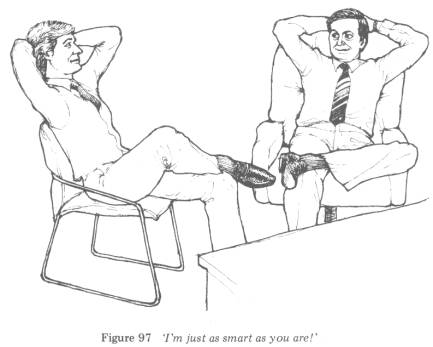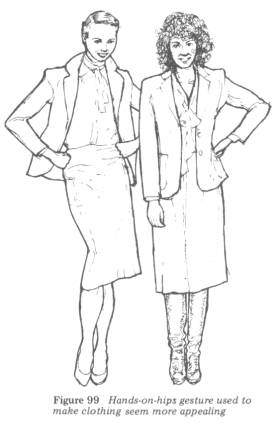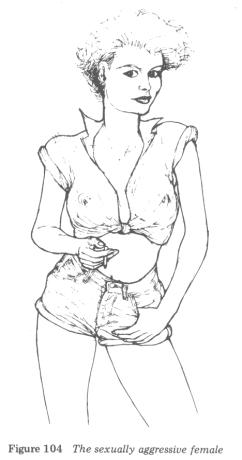Body Language: How to Read Others' Thoughts by Their Gestures (12 page)
Read Body Language: How to Read Others' Thoughts by Their Gestures Online
Authors: Allan Pease
Tags: #Popular psychology, #Advice on careers & achieving success, #Psychology


AGGRESSIVE AND READINESS GESTURES
Which gesture is used in the following situations: the young child arguing with his parent, the athlete waiting for his event to begin and the boxer in the dressing-room waiting for the bout to start?
In each instance, the individual is seen standing with the hands-on-hips pose, for this is one of the most common gestures used by man to communicate an aggressive attitude.
Some observers have labelled this gesture ‘readiness’ which in the right context is correct, but the basic meaning is aggression. It has also been called the achiever stance, related to the goal-directed individual who uses this position when he is ready to tackle his objectives. These observations are correct because in both cases the person is ready to take action about something, but it still remains an aggressive, forward-moving gesture. Men often use this gesture in the presence of women to show an aggressive, dominant male attitude.
It is interesting to note that birds fluff their feathers to make themselves appear bigger when they are fighting or courting; humans use the hands-on-hips gesture for the same purpose, that is, to make themselves appear bigger. Males will use it as a non-verbal challenge to other males who enter their territory.
It is also important to consider the circumstances and gestures immediately preceding the hands-on-hips pose to make a correct assessment of the person’s attitude. Several other gestures can further support your conclusion. For example, is the coat open and pushed back on to the hips, or is it buttoned when the aggressive pose is taken? Closed coat readiness shows aggressive frustration, whereas coat open and pushed back (Figure 98) is a directly aggressive pose because the person is openly exposing his heart and throat in a non-verbal display of fearlessness. This position can be further reinforced by placing the - feet evenly apart on the ground or by adding clenched fists to the gesture cluster.


The aggressive-readiness clusters are used by professional models to give the impression that their clothing is for the modem, aggressive, forward-thinking woman. Occasionally the gesture may be done with only one hand on the hip and the other displaying another gesture (Figure 99). Critical evaluation gestures are often seen with the hands-on-hips pose.
Seated Readiness
One of the most valuable gestures that a negotiator can learn to recognise is seated readiness. In the selling situation, for example, if the potential buyer were to take this gesture at the end of the sales presentation and the interview had progressed successfully up to that point, the sales person could ask for the order and expect to get it. Video replays of insurance sales people interviewing potential buyers revealed that, whenever the seated readiness gesture followed the chinstroking gesture (decision-making), the client bought the policy. In contrast to this, if, during the close of the sale, the client took the arms-crossed position immediately following the chin-stroking gesture, the sale was usually unsuccessful. Unfortunately, most sales courses teach sales people always to ask for the order with little regard for the client’s body position and gestures. Learning to recognise such gestures as readiness not only helps make more sales but helps to keep many more people in the selling profession. The seated readiness gesture is also taken by the angry person who is ready for something else - to throw you out. The preceding gesture clusters give the correct assessment of the person’s intentions.


The Starter’s Position
The readiness gestures that signal a desire to end a conversation or encounter are leaning forward with both hands on both knees, Figure 101) or leaning forward with both hands gripping the chair (Figure 102). Should either of these occur during a conversation it would he wise for you to take the lead and terminate it. This allows you to maintain a psychological advantage and to keep the control.
Sexual Aggressiveness
Thumbs tucked into the belt or the tops of the pockets is the gesture display used to show a sexually aggressive attitude. It is one of the most common gestures used in television Westerns to show viewers the virility of their favourite gunslinger (Figure 103). The arms take the readiness position and the hands serve as central indicators, highlighting the genital region. Men use this gesture to stake their territory or to show other men that they are unafraid. When it is used in the presence of females, the gesture can be interpreted as, ‘I am virile, I can dominate you’.


This gesture, combined with expanded pupils and one foot pointing toward a female, is easily decoded by most women. It is this gesture that non-verbally gives the game away for most men, as they unwittingly tell the woman what is on their mind. This cluster has always been predominantly male, but the fact that women wear jeans and trousers has allowed them to use the same cluster (Figure 104), although they usually only do it when wearing pants or trousers. When wearing dresses or the like, the sexually aggressive female displays one thumb tucked into a belt or pocket (Figure 104).
Male-Male Aggression
Figure 105 shows two men sizing each other up, using the characteristic hands-on-hips and thumbs-in-belt gestures. Considering that they are both turned at an angle away from each other and the lower halves of their bodies are relaxed, it would be reasonable to assume that these two males are unconsciously evaluating each other and that an attack is unlikely. Their conversation may be casual or friendly but a completely relaxed atmosphere will not exist until their hands-on-hips gestures cease and open palm gestures are used.
If these two men had been directly facing each other with their feet planted firmly on the ground, a fight would be likely to occur (Figure 106).

